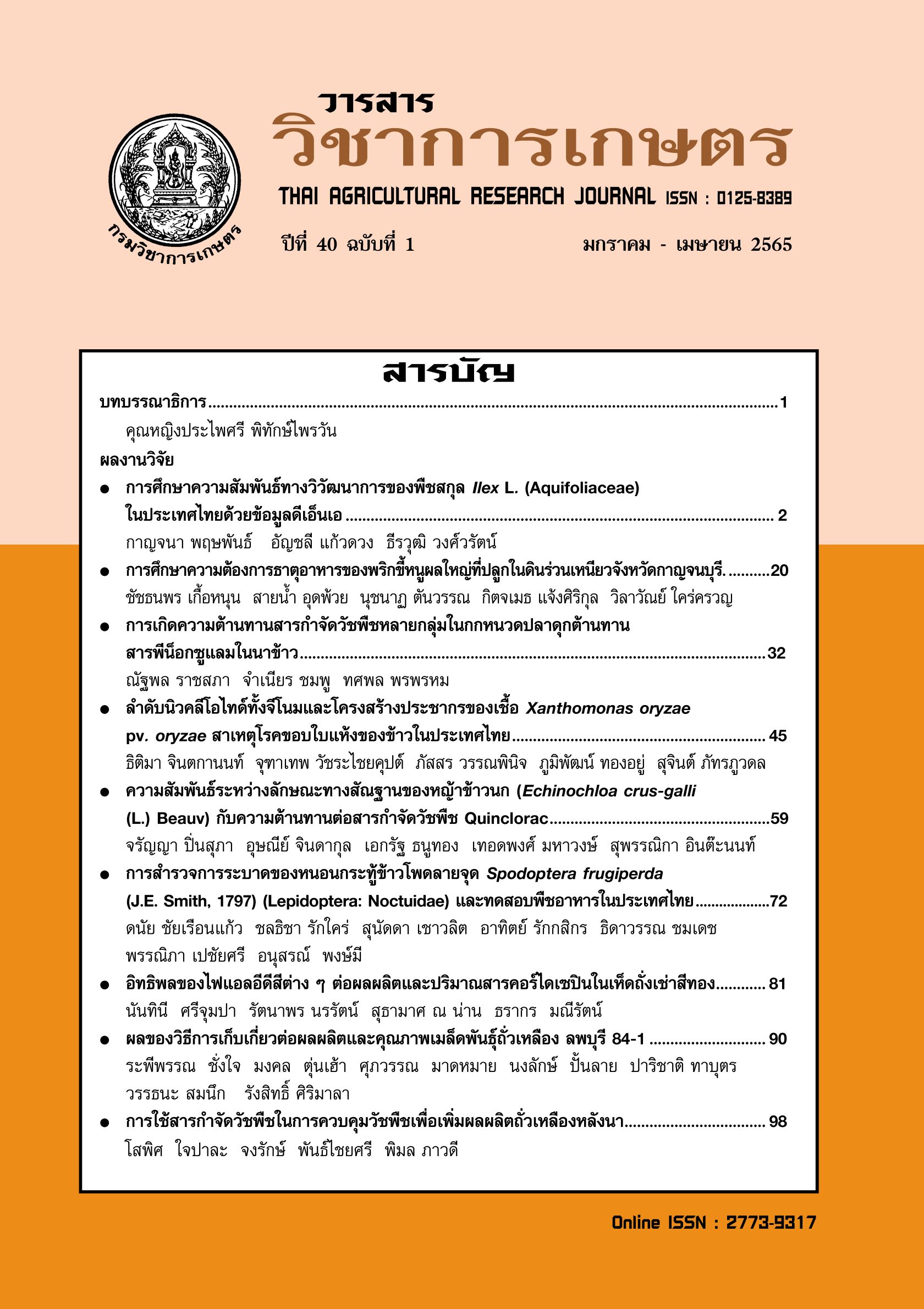ความสัมพันธ์ระหว่างลักษณะทางสัณฐานของหญ้าข้าวนก (Echinochloa crus-galli(L.) Beauv) กับความต้านทานต่อสารกำจัดวัชพืช Quinclorac
DOI:
https://doi.org/10.14456/thaidoa-agres.2022.5คำสำคัญ:
หญ้าข้าวนก, ความเหมาะสมในการอยู่รอด, วัชพืชต้านทานสารกำจัดวัชพืช, ควินคลอแรกบทคัดย่อ
หญ้าข้าวนก (Echinochloa crusgalli (L.) Beauv) เป็นวัชพืชที่เป็นปัญหาในนา ข้าว สารกำจัดวัชพืช quinclorac ถูกนำมาใช้ ในการควบคุมกำจัดหญ้าข้าวนกมาเป็นระยะ เวลากว่า 20 ปีแต่ในช่วง 4-5 ปีที่ผ่านมาไม่ สามารถควบคุมได้ งานวิจัยนี้มีวัตถุประสงค์ เพื่อศึกษาลักษณะทางสัณฐานของหญ้าข้าวนก ที่มีความสัมพันธ์กับความต้านทานต่อสารกำจัด วัชพืช quinclorac ดำเนินการทดลองเก็บเมล็ด หญ้าข้าวนก จำนวน 15 ประชากร จากพื้นที่ ปลูกข้าว 10 จังหวัด นำประชากรหญ้าข้าวนก มาตรวจสอบความต้านทานต่อสาร quinclorac และศึกษาลักษณะสัณฐานวิทยา ในเรือนทดลอง กลุ่มวิจัยวัชพืช ในปี พ.ศ. 2560-2562 และ วิเคราะห์การจัดกลุ่มด้วยเทคนิค clusteranalysis โดยใช้ข้อมูลทางสัณฐานวิทยาทั้งด้านคุณภาพและ ปริมาณ การศึกษาพบว่า ประชากรหญ้าข้าวนก มีความต้านทานและอ่อนแอต่อสาร quinclorac ที่จำนวน 8 และ 7 ประชากร ตามลำดับ โดย ประชากรต้านทานพบประวัติการใช้สารกำจัดวัชพืช quinclorac มาก่อน ประชากรต้านทาน ให้จำนวนเมล็ดต่อช่อดอกตำ่ กว่าประชากรอ่อนแอ และประชากรต้านทานส่วนใหญ่ มากกว่า 87.5% มีหางเมล็ดยาว 1.4-2.6 ซม. ต้นสูง 113-124.3 ซม. โคนต้นและขอบใบสีเขียว และมีหางเมล็ดสี เขียว หรือเขียวปนแดงในขณะที่ประชากรอ่อนแอ 85.7% มีหางเมล็ดยาว 6.3-13.8 ซม.ต้นสูง 131- 157 ซม. มีโคนต้น ขอบใบและหางเมล็ดสีแดง ผลการวิเคราะห์การจัดกลุ่มด้วยลักษณะทาง สัณฐานวิทยา สามารถแบ่งกลุ่มประชากรหญ้า ข้าวนกเป็น 2 กลุ่ม สอดคล้องกับผลการตรวจ สอบความต้านทาน การศึกษานี้ให้ข้อมูลการ สังเกตลักษณะประชากรหญ้าข้าวนกที่ต้านทาน ต่อสาร quinclorac ซึ่งจะช่วยให้เกษตรกรจัดการกับปัญหาวัชพืชต้านทานสารกำจัดวัชพืชได้ทัน เหตุการณ์
เอกสารอ้างอิง
กลุ่มวิจัยวัชพืช. 2554. คำแนะนำการควบคุมวัชพืชและการใช้สารกำจัดวัชพืช. สำนักวิจัยพัฒนาการอารักขาพืช กรมวิชาการเกษตร กรุงเทพฯ. 149 หน้า.
จรรยา มณีโชติ. 2558. วัชพืชต้านทานสารกำจัดวัชพืช (Herbicides Resistant Weed). เอกสารประกอบการฝึกอบรม หลักสูตรการจำแนกการจัดการและการใช้สารกำจัดวัชพืชอย่างปลอดภัย, 30 มีนาคม- 1 เมษายน 2558. กลุ่มวิจัยวัชพืช สำนักวิจัยพัฒนาการอารักขาพืช กรมวิชาการเกษตร
จรรยา มณีโชติ ปรัชญา เอกฐิน และยุรวรรณ อนันตนมณี. 2560. พื้นที่เสี่ยงต่อการระบาดของหญ้าข้าวนกที่มีกลไกความต้านทานต่อสารกำจัดวัชพืชแบบ multiple resistance ในนาข้าว. แหล่งข้อมูล: https://www.doa.go.th/research/attach ment.php?aid=2646. สืบค้น: 19 พฤศจิกายน 2564.
ไชยยศ สุพัฒนกุล และเบญจพล สุวรรณสิงห์. 2536. การเบียดเบียนของหญ้าข้าวนกที่มีความ หนาแน่นต่าง ๆ กัน ต่อต้นข้าว. หน้า 1-17. ใน: ผลงานวิจัยปี 2536 กลุ่มงานวิทยาการวัชพืช. กองพฤกษศาสตร์และวัชพืช กรมวิชาการเกษตร.
ประสาน วงศาโรจน์. 2540. การจัดการวัชพืชในนาข้าว. กองพฤกษศาสตร์และวัชพืช กรมวิชาการเกษตร กระทรวงเกษตรและสหกรณ์กรุงเทพฯ. 156 หน้า.
สมาคมวัชพืชแห่งประเทศไทย. 2545. วัชพืชสามัญภาคกลาง. หจก. ฟันนี่พับบลิชชิ่ง, กรุงเทพฯ. 135 หน้า.
Altop, E.K., K. Jabran and H. Mennan. 2018. Determination of morphological and genetic diversity of ALS (acetolactate synthase)- herbicide-resistant Echinochloa oryzoides biotypes in rice. Available at: http://www. fspublishers.org/published_papers/32215. pdf. Accessed: June 10, 2021.
Altop, E.K. and H. Mennan. 2011. Genetic and morphologic diversity of Echinochloa crus-galli populations from different origins. Available at: https://www.researchgate.net/ publication/225753176. Accessed: June 10, 2021.
European Herbicide Resistance Committee. 2017. Committee European Guidelines to conduct herbicide resistance tests. Available at: http://hracglobal.com/europe/files/docs/ Europe_Guidelines_Herbicide_Resis tance-tests_13Oct17.pdf. Accessed: December 13, 2017.
Etten, M.L.V, A. Kuester, S.M. Chang and R.S. Baucom. 2016. Fitness costs of herbicide
resistance across natural populations of the common morning glory, Ipomoea purpurea. Evolution. 70(10): 2199-2210.
Grossmann, K. 1998. Quinclorac belongs to a new class of highly selective auxin herbicides. Weed Sci. 46:707-716.
Heap, I.M. 2021. The International Survey of Herbicide Resistant Weeds. Available at: http://www.weedscience.org/Pages/Recent Cases.aspx. Accessed: September16,2021.
Julianoa,L.M., M.C. Casimerob and R.S.Llewellync. 2010. Multiple herbicide resistance in barnyardgrass (Echinochloa crus-galli) in direct-seeded rice in the Philippines. International J. Pest Management. 56(4): 299-307.
Juraimi, A.S., A. Tasrif, J. Kadir, S.S. Sastroutomo and S. Napis. 2005. Morphological and RAPD variability among Malaysian ecotypes of barnyard grass (Echinochloa crus-galli var. crus-galli (L) P.Beauv.). Plant Prot. Q. 20(2):52.
Koo, S.J., J.C. Neal and J.M. DiTomaso. 1997. Mechanism of Action and Selectivity of Quincloracin Grass Roots. Pestic. Biochem. Physiol. 57:44-53.
Llewellyn, R.S. and S.B. Powles. 2001. High levels of herbicide resistance in rigid rye-grass (Lolium rigidum) in the wheat belt of Western Australia. Weed Technology. 15(2):242-248.
Lopes-Martines, N., A.P. Salva, R.P.Finchand and R.D. Prado. 1999. Molecular markers indicate intraspecific variation in the control of Echinochloa spp. with quinclorac. Weed Sci. 47(3): 310-315.
Lamoureux, G. and D. Rusness. 1995. Quinclorac absorption, translocation, metabolism, and toxicity in leafy spurge (Euphorbia esula). Pest. Biochem. and Physio. 53(3): 210-226.
Malik, M.S., N.R. Burgos and R.E. Talbert. 2010. Confirmation and control of propanil resistant and quinclorac-resistant barnyardgrass (Echinochloa crus-galli) in rice. Weed Technol. 24(3):226–233.
Malik, M.S., R.E. Talbert, N.R. Burgos, B.V. Ottis and A.T. Ellis. 2003. Characterization of herbicide resistant biotypes of barnyardgrass. AAES Research Series 517:116-121.
Mallory-Smith, C. A. and E. J. Retzinger. 2003. Revised classification of herbicides by site of action for weed resistance management strategies. Weed Technol. 17(3):605–619.
Matzenbacher, F.O., E.D. Bortoly, A. Kalsing and A. Merotto. 2014. Distribution and analysis of the mechanisms of resistance of barnyardgrass (Echinochloa crus-galli) to imidazolinone and quinclorac herbicides. J. Agric. Sci. 153(6):1044-1058.
Noda K., M.,Teerawatsakul C., Prakongvongsand L. Chaiwiratnukul 1994. Major Weeds in Thailand. Revised, Enlarged Third Edition Chatuchak, Bangkok. 164 p.
Qiong, P.E., H.A. Heping, Y.A. Xia, B.A. Lianyang, Y.U. Qin and S.B. Powles.2019. Quinclorac Resistance in Echinochloa crus-galli from China. Rice Sci. 26(5):300-308.
Rahman, M.M., I.B. Sahid and A.S. Juraimi. 2010. Study on resistant biotypes of Echinochloa crus-galli in Malaysia. Aust. J. Crop Sci. 4(2):107-115.
Romeburg, C.H. 1984. Cluster Analysis for Researchers. Wadsworth, Inc. USA. 344 p.
Rutledge, J., R.E. Talbert and C.H. Sneller. 2000. RAPD analysis of genetic variation among propanil-resistantand susceptible Echinochloa crus-galli populations in Arkansas. Weed Sci. 48:669-674.
Sheng, G.S., M. Vila-Aiub, R. Busi, D. Goggin and S.J. Powles. 2019. Physiological fitness cost associated with glyphosate resistance in Echinochloa colona: seed germination ecology. J Trop. Plant Physio. 11(2):1-12.
Thanawong, K., S.R. Perret and C. Basset-Mens. 2014. Eco-effificiency of paddy rice production in North eastern Thailand: a comparison of rain-fed and irrigated cropping systems. J. Clean. Prod. 73:204- 217.
Talbert, R.E. and N. R. Burgos. 2007. History and management of herbicide-resistant barnyardgrass (Echinochloa crus-galli) in Arkansas rice. Weed Technol. 21(2): 324–331
Tasrif, A., A.S. Juraimi, J. Kadir, S.S. Sastroutomo and S. Napis. 2004. Genetic diversity of Echinochloa crusgalli var. crus-galli (L.) Beauv. (Barnyardgrass: Poaceae) ecotypes in Malaysia and Indonesia as revealed by RAPD markers. Asian J. Plant Sci. 3:231–238.
Vila-Aiub, M.M., P. Neve and S.B. Powles. 2010. Fitness Costs of Evolved Herbicide Resistance. Available at: https://www. researchgate.net/publication/255823329_ Evolved_Herbicide_Resistance_ Fitness_Costs. Accessed: May 26, 2021.
Yang, S.F. and N.E. Hoffman. 1984. Ethylene biosynthesis and its regulation in higher plants. Ann. Review Plant Physio. 35: 155-189.
ดาวน์โหลด
เผยแพร่แล้ว
รูปแบบการอ้างอิง
ฉบับ
ประเภทบทความ
สัญญาอนุญาต
ลิขสิทธิ์ (c) 2022 วารสารวิชาการเกษตร

อนุญาตภายใต้เงื่อนไข Creative Commons Attribution-NonCommercial-NoDerivatives 4.0 International License.
วารสารวิชาการเกษตร



